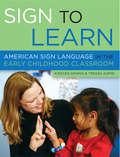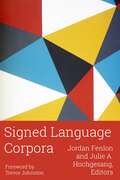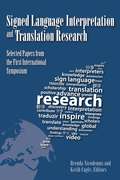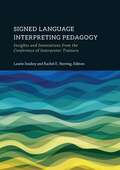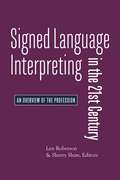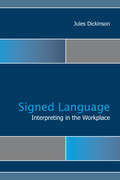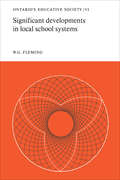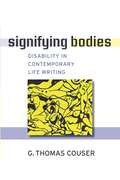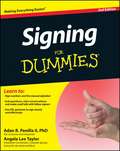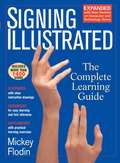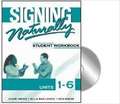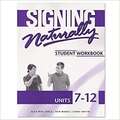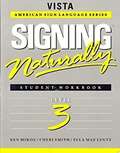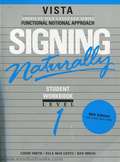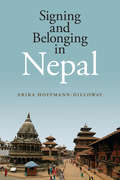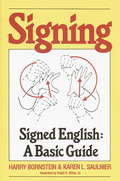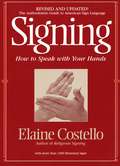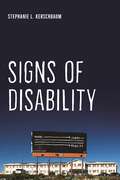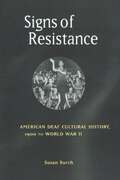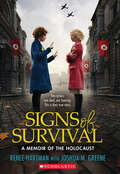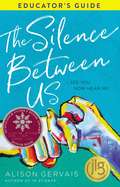- Table View
- List View
Sign to Learn
by Kirsten Dennis Tressa AzpiriEveryone is talking about signing with young children. As a form of early communication for infants and toddlers, or as a transitioning tool for children just beginning to speak, the benefits of signing with hearing children are endless.Sign to Learn is the first complete introduction to sign language curriculum for hearing preschoolers. In this unique resource, you will learn how to integrate American Sign Language (ASL) into your classroom to enhance the academic, social, and emotional development of children, and how to respectfully introduce children to Deaf culture.This comprehensive, fully illustrated curriculum contains captivating activities and lesson plans grouped by themes, including feelings, food, seasons, animals, songs, and families. Sign to Learn also contains strategies for using sign language with children with special needs and in multilingual classrooms, and it describes how ASL can assist you in developing a literacy program and in managing your classroom.Information-rich appendices include a thorough ASL illustration index, sample letters to families, and resources for further reading.
Signed Language Corpora (Gallaudet Sociolinguistics #25)
by Jordan Fenlon Julie A. HochgesangJordan Fenlon and Julie A. Hochgesang present a revolutionary contribution to the field of signed language linguistics with Signed Language Corpora, the first volume to provide a comprehensive overview of the creation, development, and use of signed language corpora. This work will advance discussions on corpus linguistics as a methodology and its place in signed language linguistics research. The ability to search corpora to obtain information about the frequency of patterns in language is an important step forward for signed language research. Access to large datasets will expand scholarly understandings of signed language structure in ways never before possible. Through reflective discussions on the processes of creating, using, and utilizing corpora, the editors and contributors hope that other linguists will be inspired to take similar steps. The descriptions provided in this book have been written to provide a framework for those eager to develop or make use of signed language corpora for their respective signed language varieties. Creating signed language corpora is significant not only for linguistic research, but for the long-term preservation of collected texts that include the stories and histories of signed language communities. Additional areas of focus include the use of signed language corpora in applied settings, the ethics of working with signed language communities, and the future of this methodology in research.
Signed Language Interpretation and Translation Research: Selected Papers from the First International Symposium
by Keith Cagle Brenda NicodemusThis volume brings together the best research presented at the first International Symposium on Signed Language Interpreting and Translation Research. Editors Brenda Nicodemus and Keith Cagle have gathered an international group of contributors who are recognized leaders in signed language interpreter education and research. The ten papers in Signed Language Interpretation and Translation Research cover a range of topics, including the need for Deaf perspectives in interpretation research, discourse strategies and techniques that are unique to video relay call settings, the benefits of using sociology as a lens for examining sign language interpreting work, translating university entrance exams from written Portuguese into Libras (Brazilian Sign Language), the linguistic choices interpreters make when interpreting ASL figurative language into English, the nature of designated interpreting, and grammatical ambiguity in trilingual VRS interpreting. The research findings and insights contained here will be invaluable to scholars, students, and practitioners.
Signed Language Interpreting Pedagogy: Insights and Innovations from the Conference of Interpreter Trainers (The Interpreter Education Series #13)
by Laurie Swabey Rachel E. HerringFor over forty years, the Conference of Interpreter Trainers has provided opportunities for advancing teaching and learning in interpreter education. This volume highlights fifteen seminal papers from past conference proceedings, along with newly written responses to the selected papers. Many of the new contributions are co-written by the author of the original paper and one or more emerging scholars, giving readers a historical lens on how the field of signed language interpreting pedagogy has evolved. The volume also calls attention to issues with which the field must urgently contend, such as implementing a Deaf-centric approach, multicultural interpreting curricula, the recruitment and retention of African American/Black students, and social justice. The contributors explore other important topics in interpreter education including ethics, Deaf translation, performance evaluation, consecutive and simultaneous interpreting, discourse analysis, critical thinking, curriculum sequencing, the social construction of learning, and mentoring. Through this collaborative approach featuring more than thirty scholars, Signed Language Interpreting Pedagogy presents a wealth of theoretical and practical information for interpreter educators and their students.
Signed Language Interpreting in the 21st Century: An Overview of the Profession
by Len Roberson Sherry ShawThis text provides interpreting students with a broad knowledge base that encompasses the latest research, addresses current trends and perspectives of the Deaf community, and promotes critical thinking and open dialogue about the working conditions, ethics, boundaries, and competencies needed by a highly qualified interpreter in various settings. This volume expands the resources available to aspiring interpreters, including Deaf interpreters, and incorporates the voices of renowned experts on topics relevant to today’s practitioners. Each chapter provides students with objectives, keywords, and discussion questions. The chapters convey clear information about topics that include credentialing, disposition and aptitude for becoming an interpreter, interpreting for people who are DeafBlind, and working within specialty settings, such as legal and healthcare. A key resource for interpreter certification test preparation, this text follows the interpreter’s ethical, practical, and professional development through a career of lifelong learning and service.
Signed Language Interpreting in the Workplace
by Jules DickinsonThe last forty years have seen a dramatic change in the nature of work, with deaf people increasingly moving into white collar or office-based professions. The rise of deaf professionals has led to employment opportunities for signed language interpreters across a variety of workplace settings, creating a unique set of challenges that require specialized strategies. Aspects such as social interaction between employees, the unwritten patterns and rules of workplace behavior, hierarchical structures, and the changing dynamics of deaf employee/interpreter relationships place constraints upon the interpreter’s role and interpreting performance. Jules Dickinson’s examination of interpreted workplace interactions is based on the only detailed, empirical study of this setting to date. Using practitioner responses and transcripts of real-life interpreted workplace interactions, Dickinson’s findings demonstrate the complexity of the interpreter’s role and responsibilities. The book concentrates on the ways in which signed language interpreters affect the interaction between deaf and hearing employees in team meetings by focusing on humor, small talk, and the collaborative floor. Signed Language Interpreting in the Workplace demonstrates that deaf employees require highly skilled professionals to enable them to integrate into the workplace on a level equal with their hearing peers. It also provides actionable insights for interpreters in workplace settings that will be a valuable resource for interpreting students, practitioners, interpreter trainers, and researchers.
Significant Developments in Local School Systems: Ontario's Educative Society, Volume VI
by W. G. FlemingThis volume deals with innovative developments of many different kinds in the local school systems in the years up to 1970. Information was obtained from a sampling of school boards, including the largest. The major purpose is to show what may be expected from an educational organization that gives local authorities a certain amount of leeway to depart from standard procedures. Innovations in teaching, curricular experimentation, changes in the structure and use of school buildings, and the growth of special services are fully covered.
Signifying Bodies
by G. Thomas Couser"Thomas Couser'sSignifying Bodiescomes at a crucial moment when debates about physician assisted suicide, genetic engineering, and neo-natal screening are raising the question of what constitutes a 'life worth living' for persons with disabilities. Couser's work engages these debates by exploring the extensive number of personal narratives by or about persons with disabilities. As Couser brilliantly demonstrates through synoptic readings, these works challenge the 'preferred rhetorics' by which such narratives are usually written (triumphalist, gothic, nostalgic) while making visible the variegated nature of embodied life. " ---Michael Davidson, University of California, San Diego "Signifying Bodiesshows us that life writing about disability is . . . everywhere. . . . From obituary to documentary film to ethnography to literary memoir to the law, the book casts a wide net, detailing how various written and filmed responses to disability both enact and resist conventional narrative patterns. [This] not only broadens our idea about where to look for life writing, but also demonstrates how thoroughly stereotypes about disability mediate our social and artistic languages---even when an author has (so-called) the best intentions. " ---Susannah B. Mintz, Skidmore College Memoirs have enjoyed great popularity in recent years, experiencing significant sales, prominent reviews, and diverse readerships. Signifying Bodiesshows that at the heart of the memoir phenomenon is our fascination with writing that focuses on what it means to live in, or be, an anomalous body---in other words, what it means to be disabled. Previous literary accounts of the disabled body have often portrayed it as a stable entity possibly signifying moral deviance or divine disfavor, but contemporary writers with disabilities are defining themselves and depicting their bodies in new ways. Using the insights of disability studies and source material ranging from the Old and New Testaments to the works of authors like Lucy Grealy and Simi Linton and including contemporary films such asMillion Dollar Baby, G. Thomas Couser sheds light on a broader cultural phenomenon, exploring topics such as the ethical issues involved in disability memoirs, the rhetorical patterns they frequently employ, and the complex relationship between disability narrative and disability law. G. Thomas Couser is Professor of English at Hofstra University.
Signing For Dummies
by Angela Lee Taylor Adan R. Penilla IIThe fast and easy way to grasp this evolving and growing languageAmerican Sign Language (ASL) is something we've all seen deaf people use in restaurants, hospitals, airports, and at work. The communication is fascinating to watch; to see people sharing ideas by using handshapes and body language is remarkable in a world so defined by sound. This new edition of Signing For Dummies gives you a general understanding of the properties of Sign, as well as an understanding of deaf culture. Designed to act as an introduction or a refresher, the book focuses solely on ASL, which is the most commonly used sign language in the United States. Categorized by subject, this illustrated guide covers grammar and sentence structure, along with the tools to get you going in basic conversation by knowing how to introduce and greet people; ask questions and make small talk; order food and chat with salespeople; handle medical emergencies; talk on the phone; get around town for fun or business; and much more. Plus, it stresses how ASL isn't just about using your fingers, hands, and arms, but also about facial expression and body language.More than 25 percent new and revised content, including the latest technological advances for the deaf; contact signing, code mixing, code switching, interpreting as a profession, and regionalism in signingPacked with "Fun & Games" sections that invite you to practice specific signsHundreds of illustrations throughout, plus a video CD featuring demonstrations by ASL signers showing actual conversationsSigning For Dummies is the fast and fun way to get you moving your hands, body, and face to convey meaning that reaches beyond linguistic barriers.
Signing Illustrated
by Mickey Flodin"Whether you have a casual interest in signing, or a sincere desire to communicate with deaf people, Signing Illustrated provides all the basic vocabulary and instructions you need to learn how to sign. Even though it takes considerable time to become a proficient signer, you will soon be signing basic concepts after studying only a chapter or two. Persons who are deaf are pleased when others learn their language, and they are patient and understanding with the beginning signer." Each chapter covers a specific category of signs, making this a useful reference tool.
Signing Naturally Units 1-6
by Cheri Smith Ella Mae Lentz Ken MikosThis introductory workbook and DVDs supplement and reinforce classroom instruction in ASL. Features cultural sections and profiles of famous Deaf people. Accompanying DVDs include over seven hours of ASL video clips.
Signing Naturally Units 7-12
by Cheri Smith Ella Mae Lentz Ken MikosSigning Naturally Student Workbook, Units 7-12
Signing Naturally: Level 3 (Vista American Sign Language)
by Cheri Smith Ella Mae LentzVideotext (DVDs in place of videotapes) and workbook designed to provide a way to review and practice what is learned in the classroom. Each of the units revolves around a major language function such as asking for and giving directions and talking about life events.
Signing Naturally: Student Workbook Level 1
by Cheri Smith Ella Mae Lentz Ken MikosAn excellent resource book, with over 1000 signs and 100 useful phrases. Activities are video-interactive, with the emphasis on language in context, featuring useful vocabulary and expressions. Readings about culture and language are included to enhance your understanding of ASL and the Deaf experience.
Signing Naturally: Student Workbook, Units 1-6
by Cheri Smith Ella Mae Lentz Ken MikosSigning Naturally is a student workbook for teaching sign language at every major college and university. It has impressive enhancements for both inside and outside of the classroom. Features include classroom exercises for Units 1-5 Signing Naturally is a student workbook for teaching sign language at every major college and university. It ensures that students use their book in class or out-of-class to study, topic index allows students to find specific parts of their homework that include key vocabulary and grammar. Culture notes and bios of important deaf people increase students' understanding of the Deaf World.
Signing Naturally: Student Workbook, Units 7-12
by Cheri Smith Ella Mae Lentz Ken MikosDesigned to give students a deeper insight into ASL and Deaf culture. Signing Naturally Units 7-12 Student Workbook offers homework assignments that support what you've learned in the classroom. Signing Naturally Units 7-12 Student Workbook also features Deaf culture articles and profiles of legendary Deaf leaders. There's also a topic index to help you find signs and information easily. The Signing Naturally Units 7-12 Student Workbook also includes over seven hours of ASL video material on two DVDs signed by 13 skilled native signers. Signing Naturally Units 7-12 Student Workbook is everything you need to bring your ASL skills BEYOND the classroom.
Signing and Belonging in Nepal
by Erika Hoffmann-DillowayWhile many deaf organizations around the world have adopted an ethno-linguistic framing of deafness, the meanings and consequences of this perspective vary across cultural contexts, and relatively little scholarship exists that explores this framework from an anthropological perspective. In this book, Erika Hoffmann-Dilloway presents an accessible examination of deafness in Nepal. As a linguistic anthropologist, she describes the emergence of Nepali Sign Language and deaf sociality in the social and historical context of Nepal during the last decades before the Hindu Kingdom became a secular republic. She then shows how the adoption of an ethno-linguistic model interacted with the ritual pollution model, or the prior notion that deafness results from bad karma. Her focus is on the impact of these competing and co-existing understandings of deafness on three groups: signers who adopted deafness as an ethnic identity, homesigners whose ability to adopt that identity is hindered by their difficulties in acquiring Nepali Sign Language, and hearing Nepalis who interact with Deaf signers. Comparing these contexts demonstrates that both the ethno-linguistic model and the ritual pollution model, its seeming foil, draw on the same basic premise: that both persons and larger social formations are mutually constituted through interaction. Signing and Belonging in Nepal is an ethnography that studies a rich and unique Deaf culture while also contributing to larger discussions about social reproduction and social change.
Signing with Jim (Fountas & Pinnell Classroom, Guided Reading Grade 3)
by Suzanne Slade Christine KornackiNIMAC-sourced textbook
Signing: A Basic Guide
by Karen L. Saulnier Harry Bornstein Ralph R. MillerNow available as an eBook, this quick-reference dictionary is for everyone who knows, cares about, or wants to communicate with someone who is deaf or hearing impaired. Designed by Harry Bornstein and Karen L. Saulnier, two of the foremost experts on sign language, Signing features more than one thousand black-and-white illustrations created specifically for hearing and non-hearing people who want to learn how to sign. Packed with grammar tips and vocabulary words arranged by subject for easy reference, Signing is a comprehensive guide to mastering the basics of Signed English and can be used alone or in conjunction with the Living Language video, Say it By Signing.
Signing: How To Speak With Your Hands
by Elaine CostelloAmerican Sign Language is a wonderful silent language of hands, face, and body that is rich with nuance, emotion, and grace. Bantam is proud to present the newly revised Signing : How To Speak With Your Hands, a comprehensive and easy-to-use guide that has long been the invaluable and definitive guide for families, friends, and professionals who need to communicate effectively with deaf children and adults. Now this expanded edition, with redesigned interiors and updated material, includes even more signs; large, upper-torso illustrations clearly show formation and movement of the hands, and their relation to the face and body. All the beautifully illustrated signs are accompanied by precise, easy-to-follow instructions on how to form them. This complete guide includes chapters on common phrases, the alphabet, foods and eating, health, recreation, and the newest chapter covering technology, politics. education, and music.
Signs of Disability (Crip #4)
by Stephanie L. KerschbaumHow can we learn to notice the signs of disability?We see indications of disability everywhere: yellow diamond-shaped “deaf person in area” road signs, the telltale shapes of hearing aids, or white-tipped canes sweeping across footpaths. But even though the signs are ubiquitous, Stephanie L. Kerschbaum argues that disability may still not be perceived due to a process she terms “dis-attention.”To tell better stories of disability, this multidisciplinary work turns to rhetoric, communications, sociology, and phenomenology to understand the processes by which the material world becomes sensory input that then passes through perceptual apparatuses to materialize phenomena—including disability. By adding perception to the understanding of disability’s materialization, Kerschbaum significantly expands our understanding of disability, accounting for its fluctuations and transformations in the semiotics of everyday life.Drawing on a set of thirty-three research interviews focused on disabled faculty members’ experiences with disability disclosure, as well as written narratives by disabled people, this book argues for the materiality of narrative, suggesting narratives as a means by which people enact boundaries around phenomena and determine their properties. Signs of Disability offers strategies and practices for challenging problematic and pervasive forms of “dis-attention” and proposes a new theoretical model for understanding disability in social, rhetorical, and material settings.
Signs of Resistance: American Deaf Cultural History, 1900 to World War II (History of Disability)
by Susan BurchChoice Outstanding Academic Title 2003A reinterpretation of early 20th century Deaf history, with sign language at its center During the nineteenth century, American schools for deaf education regarded sign language as the "natural language" of Deaf people, using it as the principal mode of instruction and communication. These schools inadvertently became the seedbeds of an emerging Deaf community and culture. But beginning in the 1880s, an oralist movement developed that sought to suppress sign language, removing Deaf teachers and requiring deaf people to learn speech and lip reading. Historians have all assumed that in the early decades of the twentieth century oralism triumphed overwhelmingly. Susan Burch shows us that everyone has it wrong; not only did Deaf students continue to use sign language in schools, hearing teachers relied on it as well. In Signs of Resistance, Susan Burch persuasively reinterprets early twentieth century Deaf history: using community sources such as Deaf newspapers, memoirs, films, and oral (sign language) interviews, Burch shows how the Deaf community mobilized to defend sign language and Deaf teachers, in the process facilitating the formation of collective Deaf consciousness, identity and political organization.
Signs of Survival: A Memoir of the Holocaust
by Joshua M. Greene Renee HartmanRENEE: I was ten years old then, and my sister was eight. The responsibility was on me to warn everyone when the soldiers were coming because my sister and both my parents were deaf.I was my family's ears.Meet Renee and Herta, two sisters who faced the unimaginable -- together. This is their true story.As Jews living in 1940s Czechoslovakia, Renee, Herta, and their parents were in immediate danger when the Holocaust came to their door. As the only hearing person in her family, Renee had to alert her parents and sister whenever the sound of Nazi boots approached their home so they could hide.But soon their parents were tragically taken away, and the two sisters went on the run, desperate to find a safe place to hide. Eventually they, too, would be captured and taken to the concentration camp Bergen-Belsen. Communicating in sign language and relying on each other for strength in the midst of illness, death, and starvation, Renee and Herta would have to fight to survive the darkest of times.This gripping memoir, told in a vivid "oral history" format, is a testament to the power of sisterhood and love, and now more than ever a reminder of how important it is to honor the past, and keep telling our own stories.
Silence Between Us Educator's Guide
by Alison GervaisThe Silence Between Us Educator's Guide is a companion to The Silence Between Us by Alison Gervais. This guide can be utilized in the classroom, in a home school setting, or by parents seeking additional resources. Ideal for grades 7-12.
Silencing the Voices: One Woman's Triumph Over Multiple Personality Disorder
by Jean Darby ClineJEAN is a dutiful wife who will do anything to make her marriage work. But JODY hates Jean's husband and is determined to drive them apart. Little JD just hides from it all, emerging only when Jean's painful past is more than she can bear. These are the voices that live within the mind of Jean Darby Cline. As a child, Jean suffered unspeakable mental and sexual abuse at the hands of her father. As an adult, her first husband's verbal abuse and cruel outbursts of rage echoed the violence of her childhood. Jean hoped that psychotherapy would help ease her depression-and fill in the major lapses of her memory. Instead, Jean made a startling discovery. The childhood horrors she'd endured had caused her personality to fragment into three separate entities-three people with opinions and emotions all their own...
